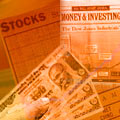Economic Survery - Indian indices record higher volatility
BSE Sensex and NSE Nifty rose by 46.7 and 39.8 per cent respectively in 2006, but were marked by strong volatility, going by the Economic Survey.
Indian indices for volatility of weekly returns were higher than foreign indices such as S&P 500 (US) and KOSPI (South Korea). Also, Indian indices recorded higher volatility on weekly returns during the two-year period January 2005-December 2006 as compared with January 2004-December 2005.
There was increased turbulence in the Indian markets partly owing to a sharp sell-off in May 2006 in line with trends in the global markets.
Larger inflows from foreign institutional investors (FIIs) and larger participation by domestic players during the later part of the year led to buoyant conditions on the bourses post a dull first half. During 2006, on a point-to-point basis, Sensex and Nifty indices rose by 46.7 and 39.8 per cent respectively.
The rise, through the year, has been attributed to growth in the profitability of Indian corporates, overall higher economic growth and other global factors such as relatively soft interest rates and fall in crude oil prices in international markets.
The market valuation of Indian stocks at the end of December 2006 stood higher than most emerging markets of Asia including South Korea, Thailand, Malaysia and Taiwan and was the second highest among emerging markets.
Retail investors
Stock markets continued to be dominated by retail investors accounting for major part of the transactions.
The gross FII turnover at Rs 20.6 lakh crore accounted for only 10.4 per cent of the total gross turnover of Rs 198.6 lakh crore in the spot and derivatives sections in 2006.
Net investment by FIIs in the equity spot market fell by around 22 per cent to Rs 36,540 crore in 2006. The number of FIIs rose by 27 per cent to 1,044 at the end of December 2006.
Going by the number of transactions, the NSE continued to occupy the third position among the world's biggest exchanges in 2006 and the BSE stood sixth slipping one step from 2005. In terms of listed companies, the BSE ranked first in the world.
Investors' wealth as reflected in market capitalisation has increased significantly by over 45 per cent during 2006.
P/E ratio
The fundamental strength of the economy was also reflected in the price-to-earnings (P/E) ratio, which was higher at a little over 20 by end December 2006 as compared to 17-18 as of end-December 2005.
As on January 12, 2007, market capitalisation (NSE) at $834 billion was 91.5 per cent of the GDP.
The NSE and the BSE spot market turnover more than doubled between 2003 and 2006.
In terms of derivatives, the turnover on NSE nearly doubled in a single year between 2005 and 2006.
Assets under management of mutual funds increased by about Rs 1.24 lakh crore to reach Rs 3.24 lakh crore in 2006.

![[Most Recent Quotes from www.kitco.com]](http://www.kitconet.com/charts/metals/gold/t24_au_en_usoz_2.gif)



![[Most Recent Exchange Rate from www.kitco.com]](http://www.weblinks247.com/exrate/24hr-inr-small.gif)















No comments:
Post a Comment